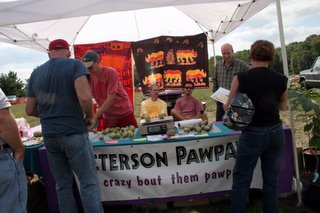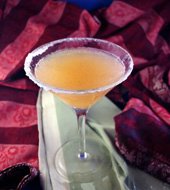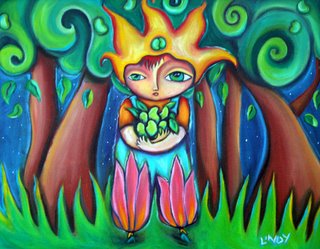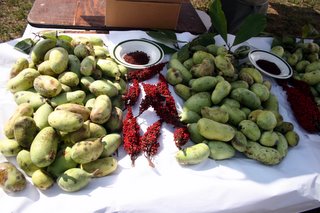Ohio Pawpaw Festival: Sept., 2005
 As this blog develops and matures, you'll be seeing and reading more about pawpaws, America's largest and, if the right strain, most delicious native fruit. Pawpaws are a member of the same family as tropical cherimoya's, often called "sugar apple" in the Caribbean. Despite the relationship, however, pawpaws thrive in a temperate climate. Their short season and short shelf life present the biggest challenge to an increasing number of growers. Traditionally, pawpaws are gathered in the wild. Their taste can vary from tree to tree. The good strains are sublime to the palate, their yellowish creamy colored flesh suggesting at once the flavors, of peach, pear, banana, and pineapple.
As this blog develops and matures, you'll be seeing and reading more about pawpaws, America's largest and, if the right strain, most delicious native fruit. Pawpaws are a member of the same family as tropical cherimoya's, often called "sugar apple" in the Caribbean. Despite the relationship, however, pawpaws thrive in a temperate climate. Their short season and short shelf life present the biggest challenge to an increasing number of growers. Traditionally, pawpaws are gathered in the wild. Their taste can vary from tree to tree. The good strains are sublime to the palate, their yellowish creamy colored flesh suggesting at once the flavors, of peach, pear, banana, and pineapple.In the picture above, wearing the orange shirt, is Neil Peterson, known also to pawpaw afficianodos as Mahatma Pawpaw. Neil has done more than anyone alive to promote and propagate pawpaw cultivation and commercialization. From a spread near Harpers Ferry, West Virginia, Neil has developed and is selling saplings that in a few years will provide fruit of a quality that is unlikely to be surpassed.
The pawpaw sunrise below, mixed and photographed in my kitchen as opposed to at the festival, is made by mixing two ounces of orange juice, 1 1/2 ounces of tequila, and 1/2 ounce of peach schnappes, to which I added 1/2 ounce of my own homemade pawpaw liqueur before shaking with cracked ice and straining into a sugar-rimmed cocktail glass.


As for the folk art piece at left, Lindy, if you still have it and still want to sell it, I hope you'll contact me.
Finally, on some of the tables pictured below, you'll observe bright red clusters of sumac buds. When ground up, sumac complements a number of pawpaw recipes.
The best way to enjoy pawpaws, however, is raw and by themselves. Get one that is a little soft, halve it lengthwise, then use a grapefruit spoon to scoop out and enjoy the pulp, while discarding the large brown seeds.




0 Comments:
Post a Comment
<< Home